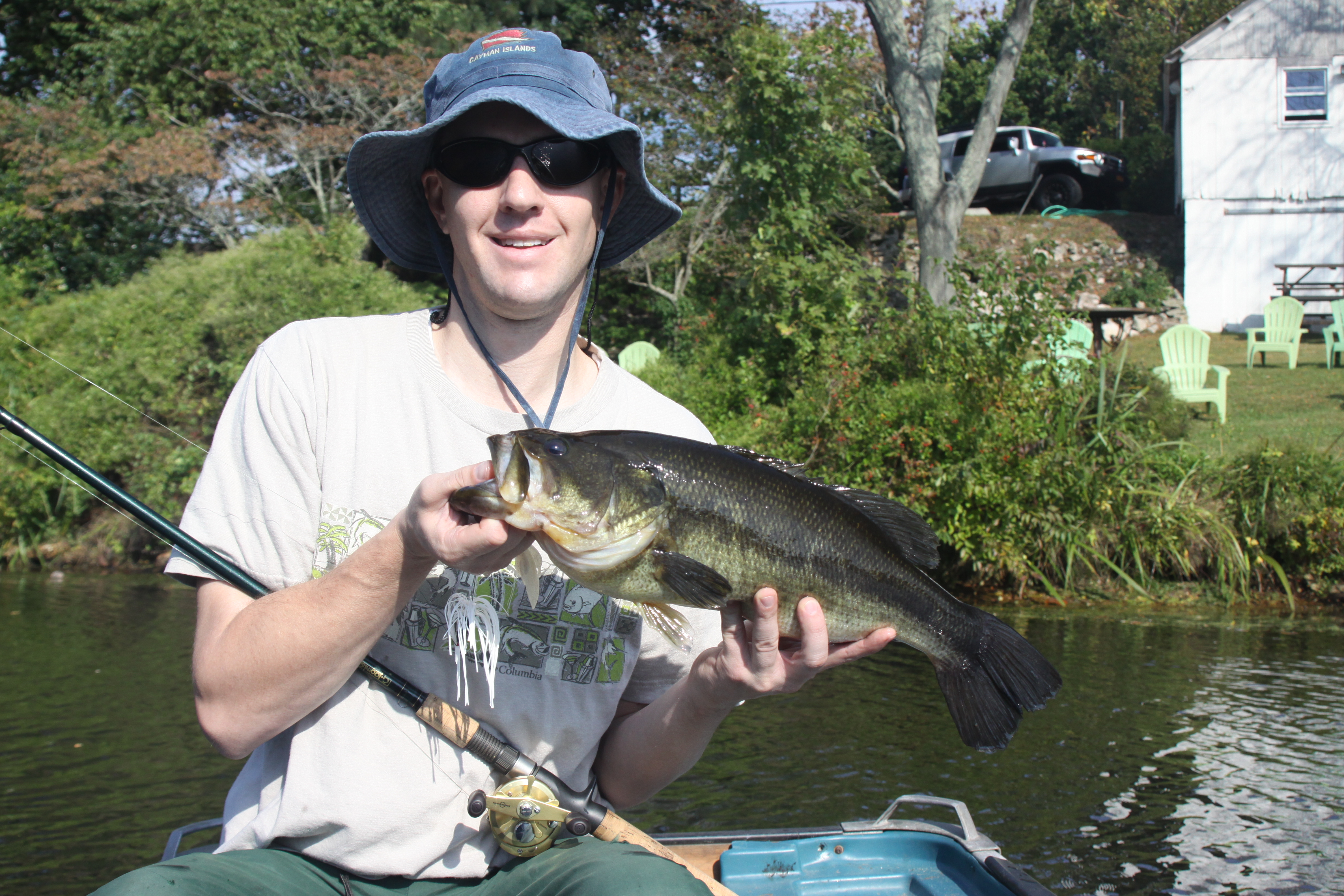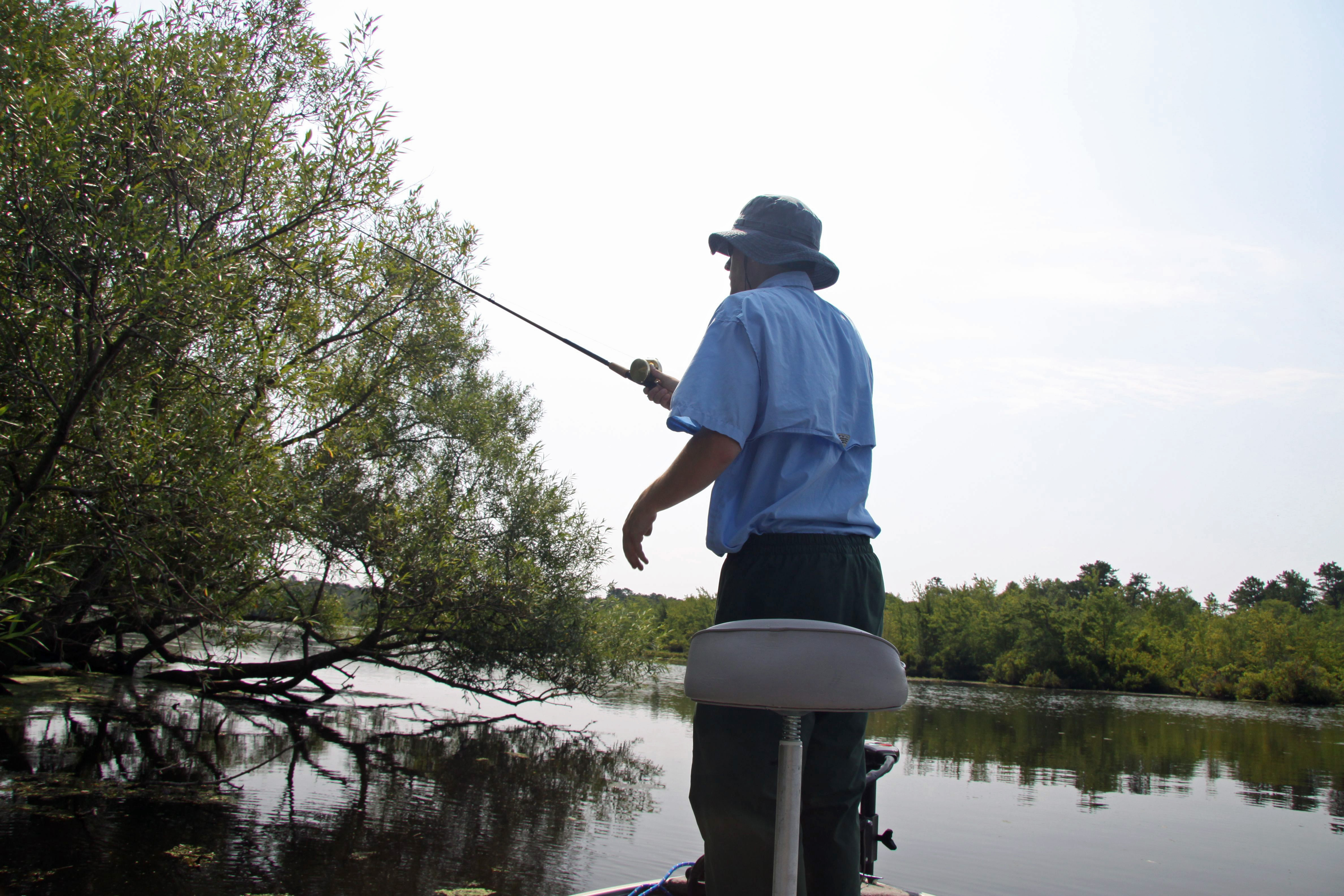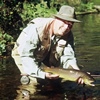JIG WOOD FOR LARGEMOUTH BASS
By Dave Lengyel

“Lunker Dave” Lengyel is an exceptionally versatile bass angler. Probe wooden structure, stumps and brush from the outside before casting to the prime strike zone, he advises. Photo by Tom Schlichter.
What do you get when you mix wood with a jig? The answer is an excellent combination to catch largemouth bass. There is no doubt that any type of wood that is either exposed or submerged has a good chance to produce bucketmouths. In the early season, the dark wood is sometimes the first thing in the pond to absorb heat and warm up. This starts algae growth, which attracts baitfish, which attracts game fish. It also provides an excellent ambush location, especially if it the wood has bends, branches or anything else that breaks up its form. This type of structure runs the entire spectrum, from lone standing stumps to whole trees that have fallen into the water. Knowing which ones produce and how to go about fishing them is one ticket to catching lunkers.
GOT TO LOVE THE JIG

Knowing how to fish wood, says Lengyel, can result in some real hawg action. If you spook a fish holding on shallow timber, circle back later and cast again from another angle, he suggests. Tom Schlichter photo.
The jig is perfectly designed for this type of fishing; it comes in all head shapes, weights and colors. I like to vary the size and even the shape depending on the conditions. Arrow or more pointed heads are good for punching straight down toward the bottom and can be your friend when weeds have grown around a tree. Rounder heads like footballs are great when dropping a jig in the wood and letting it roll off the branches, giving the impression of a meal falling haphazardly through the water.
Weight will depend on the day, sometimes a slow fall will work while other trips see a fast movement turning the head of your quarry. In some cases you will find that preferences vary during the day. This commonly happens as weather conditions are changing and is one of the reasons I carry an assortment of weights from ¼-ounce on up to 1-ounce in different head shapes. With this collection it is possible to cover anything from sparse light branches to thick, weedy, nearly unfishable areas of the wood. Usually natural colors are consistent producers, but don’t be afraid to mix it up with something different.
Adding a trailer to the jig is a good idea under most circumstances. This will change the fall rate depending on the size, shape and material that is used in the trailer. Some popular choices are natural or artificial pork chunks, rubber crayfish, and single and twin tail grubs. Always be sure to give the jig a quick check before the cast to make sure the trailer hasn’t wrapped itself around the hook. You can also use scent or a scent dunking tub to add extra flavor to your offering. Sometimes leaving your lure in the scent tub as you take a break or move from one spot to another is a good idea as this will refresh the scent on your lure and prevent pork or biodegradable trailers from drying out.

Be aware of the shadows around stumps, submerged timber and heavy wood cover. Bass love to hang in them throughout the day. Photo by Tom Schlichter.
OUTSIDE EDGES FIRST
When approaching a “fishy” looking piece of wood, it’s always a good idea to start with the outside and work your way in. Ambush predators like bass will usually sit just in from the edge and wait for unsuspecting prey to swim past. After you cast to the edge, do not immediately start the retrieve. Let the lure sink and, if necessary, peel off line so you get a straight fall and it stays in the strike zone. Being in tune with the fall rate of your lure is important since some fish will pick it up on the drop and the weight will disappear. If this happens, set the hook. Also, watching the line for any unusual movement is beneficial, especially if the fish decides to grab and swim off.
After the outside has been checked, it is time to start working in towards the middle. Look for holes in the branch formation that will allow the lure an easy drop. It is a good idea to use heavy line and a tight drag since a big fish can wrap itself up in the snags if given a little slack. It can be tricky telling a strike from a branch, but the more you do it, the better judge you will become. If you feel you have a strike, lift your rod and see if you can sense movement. If you do, set the hook with authority.
Finally it is time to go all in. Fishing really tight to wood is not for the faint of heart; it usually takes place in shallow water and the fish are easily spooked. This is where a little thinking outside the box can come in handy. Try a very light pitch, or even a flip, to present the bait quietly. You might even utilize a branch or thick patch of weeds to dampen your lure’s entry. Keep in mind that bass strike lures in many different ways, so always be prepared to set that hook. Sometimes you may even see a splash where you think your bait is, but remember to only set the hook when you feel weight on the lift. You may have just spooked a fish that was hanging in that area. If this happens, make a mental note about where it was, come back to the spot later, and hit it at a different angle because that lunker may be orienting itself a certain way in relation to the structure.
KEY ON SHADOWS
A lot of reservoirs and dammed sections of river have stumps. Usually this wood is so dense that it will last for a long time. While fishing the stumps, be sure to observe their shadows. In shallower waters, a favorite spot for the fish to hold is in such shade. Sometimes they will follow it around as the sun tracks through the sky. Also, the root systems of the stumps may be exposed. These are excellent areas to find fish if they want to come out.
Submerged trees, stumps or woody structure located in deeper water, where you cannot see, can be tricky but rewarding to fish. Nowadays with sonar, it is pretty easy to tell the orientation of what you are fishing. Still there may be times when you are on a small boat and you may not have the convenience of a sonar unit. This is when marker buoys come in handy. As you work the jig around the structure, take note where it ends and when you lose contact with it. At this point throw out a marker buoy to that area. Repeat this process as much as you want to thoroughly mark the area. Then, with the submerged tree marked, you can go about jig fishing it many ways; swimming it over the top, vertically jig, or even the bump and fall presentation.
Observation and concentration is the key to fishing woody structure. If you are in tune with your gear and how the fish are biting, your chances of hooking a hawg, or at least enjoying solid action, are pretty high whey you focus your efforts around woody structure. Remember, if you are missing fish or getting hung up, don’t give up. Just keep at it.
By Tom Schlichter
Use the LIKE button below to get notifications about new articles in your Facebook news feed!



